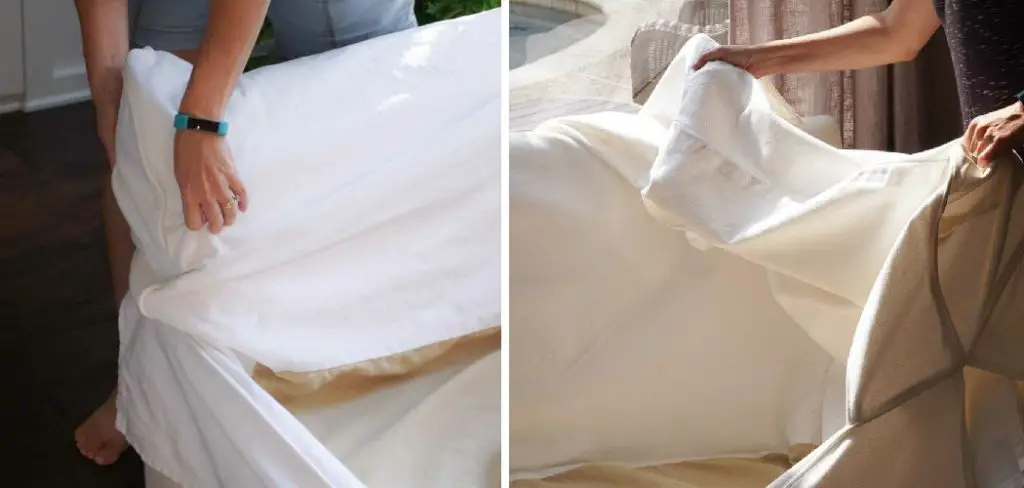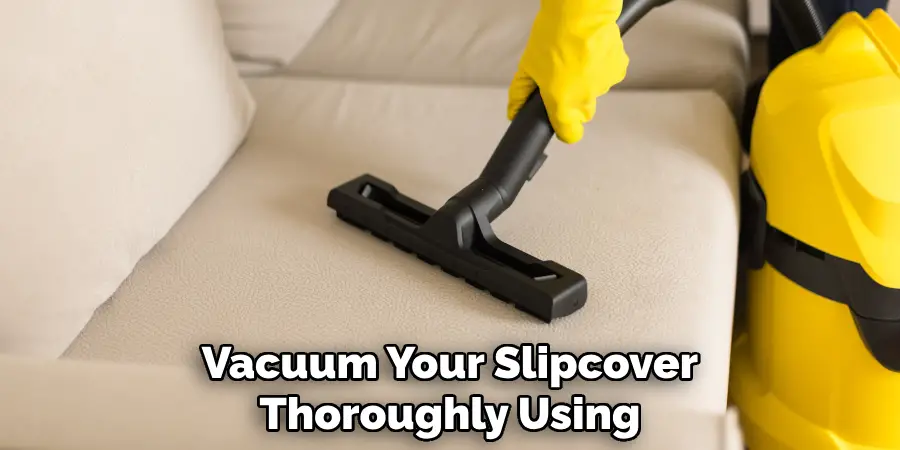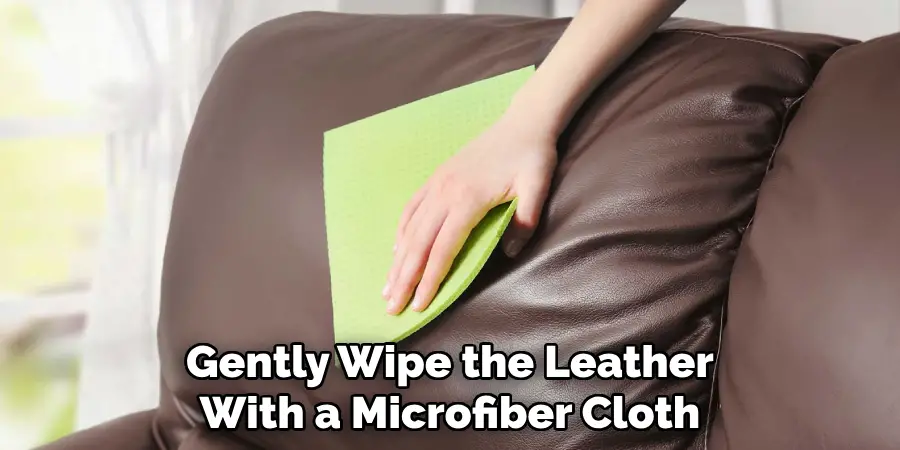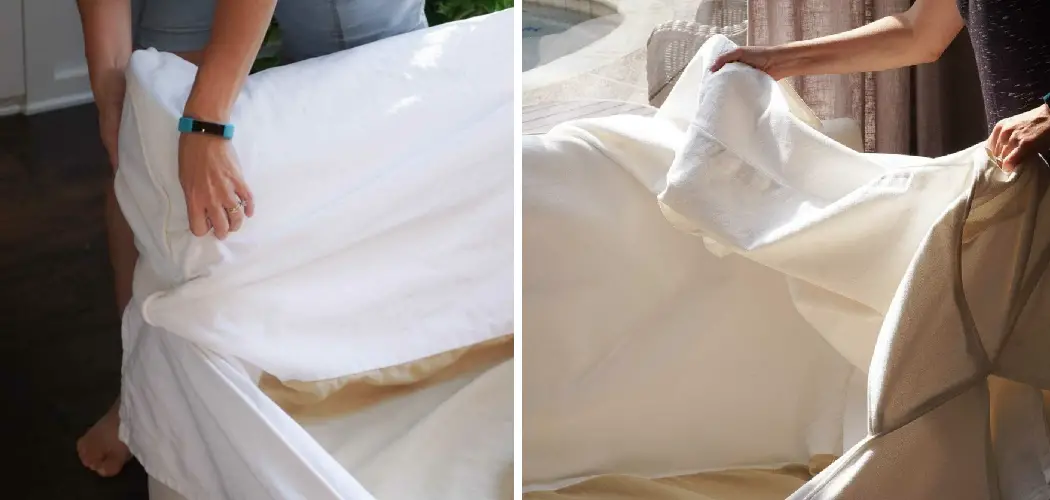Are your Pottery Barn slipcovers looking a little worse for wear? Are you curious about how to keep them fresh and clean without breaking the bank or damaging the fabric? Look no further! In this blog post, we’ll provide you with all of the tips and tricks you need to clean Pottery Barn slipcovers effectively.
All of our methods are surprisingly simple and cost-effective — so don’t let the thought of tedious scrubbing discourage you. With just a few steps, your slipcovers will be as good as new in no time at all!

So put on some rubber gloves, roll up your sleeves, and follow along as we show you How to clean Pottery Barn slipcovers— it’s easier than ever before!
Understanding Pottery Barn Slipcovers
A. Material Types and Their Characteristics
Pottery Barn slipcovers are known for their quality and durability. Here are some common materials used in their production:
1. Common Materials Used in Pottery Barn Slipcovers
- Cotton: Cotton slipcovers are popular for their softness and comfort. They are breathable, making them ideal for warm climates.
- Linen: Linen slipcovers are elegant and sophisticated. They are highly durable and resist pilling and abrasion, but they may wrinkle easily.
- Polyester: Polyester slipcovers are known for their strength and durability. They are also wrinkle-resistant and easy to care for.
2. Advantages and Challenges of Each Material
- Cotton: Cotton slipcovers are machine washable, making them easy to clean. However, they can shrink if not laundered correctly.
- Linen: Linen has a natural resistance to dirt and stains, and it can be dry-cleaned. The downside is that it wrinkles easily and may require frequent ironing.
- Polyester: Polyester is a low-maintenance fabric that resists wrinkles and shrinking. However, it may not breathe as well as other fabrics, which could make it less comfortable in hot weather.
What Will You Need?
Before jumping into the cleaning process, you’ll want to ensure you have all the necessary supplies. Here are a few things that will come in handy when tackling those Pottery Barn slipcovers:
- Upholstery cleaner (choose one that is formulated for fabric or leather)
- Microfiber cloths
- Vacuum cleaner
- Water and mild detergent
Once you’ve got your supplies, it’s time to start freshening up those slipcovers!
10 Easy Steps on How to Clean Pottery Barn Slipcovers
Step 1. Cleaning Fabric Upholstery
If your Pottery Barn slipcovers are made of a fabric such as cotton or linen, then you’ll need to use a gentle upholstery cleaner that is specifically designed for fabrics. To start off, vacuum your slipcover thoroughly using an upholstery attachment. This will help remove any dirt and debris accumulated on the fabric over time.

Step 2. Apply Upholstery Cleaner
Once vacuumed, spray your cleaner onto the slipcover in a light mist and let it sit for several minutes before scrubbing with a microfiber cloth or brush (depending on the type of fabric). Be careful not to overwet the fabric, as this can cause damage. Remember to clean the seams and folds of the slipcover as well.
Step 3. Wipe Away the Cleaner With a Cloth
Once you’ve scrubbed in all the cleaners, take a microfiber cloth and wipe away any residue that may have accumulated during cleaning. Make sure to go over all areas of the slipcover until it is scorched. If needed, you can use a dryer sheet to help reduce static.
Step 4. Vacuum Again
After the slipcover is completely dry, vacuum it again. This secondary vacuuming will help pick up any dirt or residue loosened during the cleaning process but not completely removed. Be thorough, making sure to reach into all corners and crevices. Your Pottery Barn slipcover should now look and feel fresh and clean. Remember, regular cleaning will extend the life of your slipcovers and keep them looking their best.
Step 5. Cleaning Leather Upholstery
The cleaning process is different if your Pottery Barn slipcovers are made of leather. For leather slipcovers, you’ll need a cleaner specifically designed for leather. Start by vacuuming the slipcover using an upholstery attachment, then apply the leather cleaner as directed by the product’s instructions.
Step 6. Wipe the Leather
After applying the cleaner, gently wipe the leather with a microfiber cloth. Be careful not to rub too hard, as it may damage the surface. Additionally, use a dry cloth to remove any excess cleaner and follow up with another vacuum session.

Step 7. Condition the Leather
Once cleaning is finished, it’s time to condition the leather slipcover. This will help keep it soft and supple while protecting against cracking or fading over time. Choose a leather conditioner specifically designed for
Step 8. Apply Leather Conditioner
Once the slipcover is clean, consider applying a leather conditioner. This will help to keep the leather soft and supple and prevent it from drying out and cracking. As with the cleaner, follow the product’s instructions for application.
Step 9. Regular Maintenance
Whether your slipcovers are fabric or leather, regular maintenance is key to keeping them looking their best. Regularly vacuum to remove dust and debris, and clean spills immediately to prevent staining. You can also apply a fabric protector if needed.
Step 10. Professional Cleaning
If your Pottery Barn slipcovers are heavily stained, or you need to be more comfortable cleaning them yourself, consider hiring a professional upholstery cleaning service. They have the experience and tools to effectively clean your slipcovers without causing damage. Remember, regular cleaning will extend the life of your slipcovers and keep them looking their best.
Through these easy steps, you can have your Pottery Barn slipcovers looking clean and fresh. Regular cleaning and maintenance can extend their lifespan and keep them looking new for years. Happy cleaning!
5 Additional Tips and Tricks
- Always spot clean your slipcover if a spill or mess occurs. Rub in the direction of the fabric grain using detergent and cold water on a soft cloth or sponge.
- Check for any discoloration before placing your slipcovers in the washer. If you notice any fading, wash separately from other items to prevent color transfer.
- To prevent shrinkage, use cold water and gentle detergent when washing.
- Always air dry your slipcover after washing it for the best results. High temperatures in the dryer may cause damage to the fabric as well as shrinkage.
- If you need to iron out wrinkles or creases, use a low-heat setting and press lightly from the inside of the fabric. Do not iron directly on the slipcover or you may cause damage to the fibers.

These tips and tricks should help your Pottery Barn slipcovers retain their original shape and color for a longer period. Use these cleaning methods with regular vacuuming to ensure that your slipcovers look great!
5 Things You Should Avoid
- Avoid using bleach or fabric softener when washing your slipcover, as this could damage the fabric.
- Do not rub the stain too hard, as it may distort the fabric.
- Do not leave your slipcover wet for long periods after washing, as it will result in moisture damage and discoloration.
- Avoid using an abrasive brush when spot cleaning, as this will cause the fabric to frayed and unravel.
- Do not place your slipcover in the dryer, as it will shrink and may be damaged by high temperatures.
Follow these precautions to ensure you get the longest life possible from your Pottery Barn slipcovers! With proper care and maintenance, your slipcovers should stay looking like new for years.
Can I Machine Wash My Pottery Barn Slipcovers?
No, it is not recommended to machine wash your Pottery Barn slipcovers. The fabric used on these slipcovers may shrink or be damaged in the process of machine washing and drying. It is best to spot clean with a damp cloth or sponge when necessary, followed by air drying for optimal results.
Additionally, Pottery Barn recommends using a professional cleaner for tough stains that spot cleaning cannot remove. This will help to ensure your slipcovers keep their original shape and color.
What is Slipcover Material?
Pottery Barn slipcovers are made from various materials, including cotton, linen, and polyester blends. Cotton is the most popular material for slipcovers due to its breathability and durability. Linen is another great option because it offers breathability and is easy to clean. Polyester blends are best for extra protection against spills and stains.
Another option to consider is Sunbrella fabric, which is fade and stain resistant. This fabric is ideal for families with children or pets because it provides extra protection against accidental messes.
No matter which material you choose, regular cleaning of your slipcover is important to keep it looking great for years. Follow the tips and tricks outlined above to help preserve the color and shape of your Pottery Barn slipcovers.
Should Slipcovers Be Lined?
Slipcovers should not be lined, as this will cause them to look bulky and unflattering. Instead, Pottery Barn recommends adding cushions or pillows for comfort and style. Pillows can also help disguise any wrinkles in the fabric, giving your slipcover a polished and finished look.
When selecting pillows for your slipcovered furniture, select ones that are a similar color and texture to your slipcover fabric. This will create a cohesive look and help pull the room together.

By following these tips and tricks, you can ensure your Pottery Barn slipcovers look great for years to come. With proper care and maintenance, you’ll be able to enjoy your furniture’s new look without replacing your slipcovers.
Regular Maintenance Tips
1. Vacuum regularly
Vacuum your slipcovers on a regular basis to remove dust and debris that can accumulate over time. Use the upholstery attachment on your vacuum for best results.
2. Spot clean spills immediately
If you happen to spill something on your slipcover, it’s important to clean it up right away before it has a chance to stain. Use a gentle detergent and cold water on a soft cloth or sponge to blot the spill in the direction of the fabric grain.
3. Protect your slipcovers with fabric protector
For added protection against spills, consider applying a fabric protector to your slipcover. This will create a barrier between the fabric and spills, making it easier to clean up before they have a chance to penetrate the fabric.
4. Rotate slipcovers regularly
To prevent uneven wear and tear, rotate your slipcovers regularly. This is especially important if you have multiple slipcovers for the same piece of furniture.
5. Store slipcovers properly when not in use
If you have seasonal slipcovers or are storing them for any reason, be sure to store them in a cool, dry place to prevent mold or mildew growth. Avoid storing them in plastic, as this can trap moisture and cause damage to the fabric.
By following these maintenance tips, you can keep your Pottery Barn slipcovers looking great for years and protect your investment in quality furniture.
Tips for Handling Special Cases
Stains and Spills on Leather Slipcovers
If you have leather slipcovers, it’s important to clean up spills as soon as possible to avoid permanent staining. Use a soft cloth or sponge to gently blot the spill, taking care not to rub it into the leather. If necessary, use a mild soap and water solution to remove tougher stains.
To prevent your leather slipcover from drying out and cracking, make sure to condition it regularly with a leather conditioner. This will help keep the leather supple and prevent damage.
Slipcovers for Outdoor Furniture
To clean outdoor furniture slipcovers, first remove any loose dirt or debris by vacuuming or brushing them off. Then, spot-clean any stains using a mild detergent and cold water. Rinse thoroughly and let air dry.
To protect your slipcovers from fading in the sun, consider using a UV fabric protector spray. This will help extend their lifespan and keep them looking vibrant for longer.
Conclusion
With pottery barn slipcovers, cleaning only requires some elbow grease to ensure they stay in good condition. Remember regular professional deep cleans, too; even if you’re diligent with weekly spot-treating, these covers need a deep clean every so often. Cleaning your slipcovers can ultimately extend their lifespan and save you money in the long run. If you’ve followed all the steps presented here, your slipcovers will look as good as new again.
For those who want something easier to manage or maintain without hassle, machine washable slipcovers are a wonderful solution due to their simplicity in care instruction and the convenience of washing them at home. Whatever way you decide to give your covers some TLC, we hope this article has been of value to you.
With the right know-how to clean pottery barn slipcovers and tools, having beautiful pottery barn caps on your furniture doesn’t have to be a headache!

